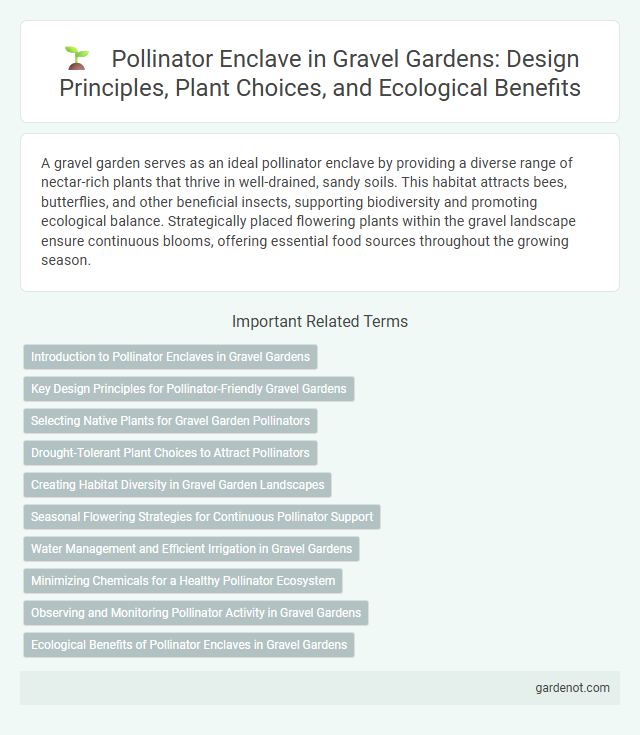A gravel garden serves as an ideal pollinator enclave by providing a diverse range of nectar-rich plants that thrive in well-drained, sandy soils. This habitat attracts bees, butterflies, and other beneficial insects, supporting biodiversity and promoting ecological balance. Strategically placed flowering plants within the gravel landscape ensure continuous blooms, offering essential food sources throughout the growing season.
Introduction to Pollinator Enclaves in Gravel Gardens
Pollinator enclaves in gravel gardens create essential habitats for bees, butterflies, and other beneficial insects by providing diverse flowering plants with staggered bloom times. These environments improve pollination efficiency and support biodiversity, enhancing both garden productivity and ecosystem health. Incorporating native, drought-tolerant perennials and ground covers optimizes the enclave's resilience and sustains pollinator populations throughout the growing season.
Key Design Principles for Pollinator-Friendly Gravel Gardens
Pollinator-friendly gravel gardens prioritize diverse native plant selection, ensuring continuous bloom periods to support bees, butterflies, and other pollinators throughout the growing season. Incorporating varied gravel textures and colors enhances soil drainage and microhabitats, promoting nesting and foraging opportunities. Strategic spatial arrangement of flowering clusters maximizes pollinator accessibility while reducing competition and supporting ecological balance.
Selecting Native Plants for Gravel Garden Pollinators
Selecting native plants for a gravel garden pollinator enclave enhances biodiversity by providing essential nectar and pollen resources specifically adapted to local pollinators such as bees, butterflies, and hoverflies. Species like Echinacea purpurea, Asclepias tuberosa, and Solidago canadensis thrive in well-drained gravel soils while supporting native pollinator populations by offering continuous blooms throughout the growing season. Incorporating drought-tolerant, native flowering perennials promotes ecological stability and resilience, ensuring sustainable pollinator habitats within gravel garden ecosystems.
Drought-Tolerant Plant Choices to Attract Pollinators
Drought-tolerant plants like lavender, coneflowers, and sedum thrive in gravel gardens, providing abundant nectar and pollen for pollinators such as bees, butterflies, and hummingbirds. These resilient species require minimal water, making them ideal for xeriscaping while supporting essential pollination processes. Incorporating native drought-resistant plants enhances biodiversity and creates a sustainable pollinator enclave in arid environments.
Creating Habitat Diversity in Gravel Garden Landscapes
In gravel garden landscapes, creating habitat diversity is essential for supporting a wide range of pollinators including bees, butterflies, and hoverflies. Incorporating native flowering plants with staggered bloom periods provides continuous nectar and pollen sources, while varied gravel textures and microhabitats foster nesting opportunities for solitary bees. Designing these pollinator enclaves enhances biodiversity, promotes ecological resilience, and sustains pollination services within urban and arid environments.
Seasonal Flowering Strategies for Continuous Pollinator Support
Gravel gardens designed as pollinator enclaves incorporate seasonal flowering strategies to ensure continuous nectar and pollen availability throughout the year. By integrating early-blooming species like Crocus and Snowdrops with mid- and late-season plants such as Echinacea and Sedum, these gardens maintain a dynamic habitat that supports diverse pollinator populations. This strategic planting promotes ecological resilience and enhances biodiversity by providing uninterrupted forage for bees, butterflies, and other beneficial insects.
Water Management and Efficient Irrigation in Gravel Gardens
Pollinator enclaves in gravel gardens benefit from strategic water management practices that optimize soil moisture retention and reduce runoff-induced erosion. Efficient irrigation methods, such as drip systems and rainwater harvesting, ensure targeted hydration with minimal water waste, fostering healthy nectar and pollen production. These techniques support pollinator diversity by maintaining optimal flowering conditions throughout varying seasonal climates.
Minimizing Chemicals for a Healthy Pollinator Ecosystem
Minimizing chemicals in a gravel garden supports a thriving pollinator enclave by preserving the natural habitat and food sources essential for bees, butterflies, and other pollinators. Using organic pest control methods and avoiding synthetic pesticides reduces toxic exposure and promotes biodiversity in the ecosystem. This approach enhances pollinator health, ensuring effective pollination and a sustainable garden environment.
Observing and Monitoring Pollinator Activity in Gravel Gardens
Gravel gardens provide an ideal pollinator enclave, fostering diverse insect populations such as bees, butterflies, and hoverflies. Regular observation and monitoring of pollinator activity through visual surveys and photographic documentation help track species diversity and abundance. Data collected informs adaptive maintenance practices, enhancing habitat quality and supporting pollination services vital for garden ecosystem health.
Ecological Benefits of Pollinator Enclaves in Gravel Gardens
Pollinator enclaves in gravel gardens create vital habitats that support a diverse range of bees, butterflies, and other beneficial insects, boosting local biodiversity. These specialized areas improve pollination rates, enhancing the health and productivity of surrounding plants while stabilizing the ecosystem. Incorporating native flowering species in gravel gardens ensures continuous nectar sources, promoting sustainable pollinator populations and ecological balance.
Pollinator enclave Infographic

 gardenot.com
gardenot.com